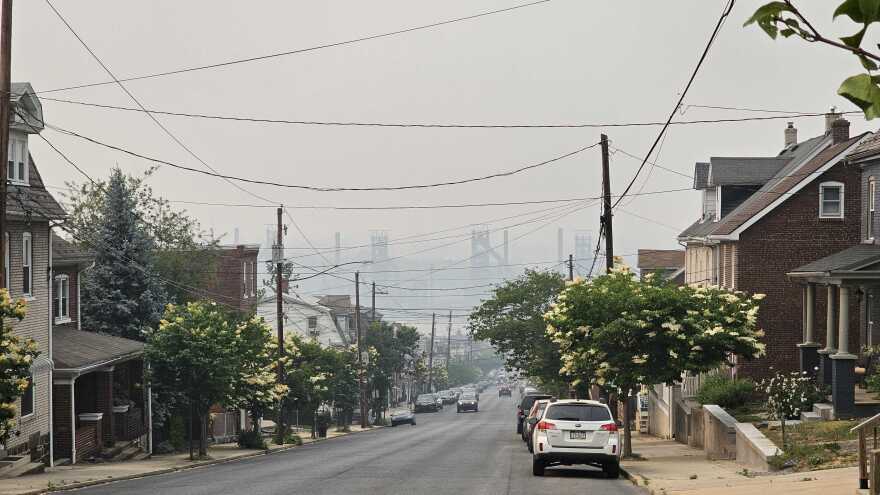BETHLEHEM, Pa. — Chrysan Cronin has never seen the Lehigh Valley’s air quality this bad.
- The Lehigh Valley continues to be inundated with hazy smoke from wildfires in Canada
- Scientists point to a mixture of geography and climate change exacerbating the smoke in the Lehigh Valley
- Researchers say this is the worst air quality they've seen in the region
“I've lived here for 30 years,” said Cronin, associate professor and director of public health at Muhlenberg College. “I've never seen it this bad.”
As she answered questions Wednesday afternoon via phone, the air quality monitors at her Hanover Township, Northampton County, home continued to climb, from 335 to 371.
“The normal level for that, where it's safe, is between zero and 12 micrograms per cubic meter,” Cronin said. “And mine right now is at 379 because it keeps going up as I'm talking to you.”
PM2.5 in μg/m3 in Hanover Township, Northampton County PA. Air quality has deteriorated to very dangerous levels in the Lehigh Valley. Protect your kids, pets, and yourself. Stay indoors with windows/doors shut if you can. Wear an N95 if you must be outdoors. pic.twitter.com/MIvEjPZqme
— Chrysan Cronin, DrPH, MPH (@CroninChrysan) June 7, 2023
Smoke from hundreds of wildfires in Canada has blanketed the Valley in a thick haze, muting the sun and casting a sepia tone across the landscape, giving residents watery eyes and choking coughs. The air quality is already bad due to prolific truck and car traffic across the region, and the smoke is making it worse.
While wildfires can be a fairly common occurrence, experts say climate change is exacerbating them through extended periods of hot, dry weather. And, the Valley — named because of its place in the trough between South Mountain and Blue Mountain — is the perfect place for smoke to settle.
What is in the air?
The haze comes from a complex mixture, said Hyunok Choi, an associate professor at Lehigh University whose research focuses on children’s prenatal and postnatal exposures to indoor and outdoor environmental pollution.
“It's a very complex mixture of both the natural substance that's burning, as well as fossil fuel, biomass,” Choi said. “And also natural fires are very hard to control. So we expect to see some much more modern chemicals.
“You could say it's a mix of thousands of chemicals.”
It’s not just trees that are burning, said Breena Holland, an associate professor of political science and the Environmental Initiative at Lehigh University.
“There's a lot of human-made structures that have painting substances on them and that comprise a lot of different chemicals and all that is burning and then floating into the air,” she said.
Those substances travel and can end up being inhaled by residents or animals. The main culprit, Cronin said, is PM 2.5, which describes the size of the particles — 2.5 micrometers or less.
“And the reason we're more concerned with those size particles than the bigger ones that are also part of all of this smoke is because those are the ones that can be inhaled, and make their way deep down into the lungs,” Cronin said. “And once they do that, they can cause a lot of lung issues, exacerbate lung issues that people might already have or cause new ones.
“And they can also make their way across the air sacs in the lungs and get into the bloodstream and circulate throughout the body.”
The air quality in Allentown, Bethlehem and Easton is so bad, it’s the equivalent of smoking more than 14 cigarettes, according to Sh**t! I Smoke, an app that compares air quality to cigarette smoking.
Climate change and geography
Scientists are pointing to climate change as the catalyst for increases in wildfires.
“Multiple studies have found that climate change has already led to an increase in wildfire season length, wildfire frequency, and burned area,” according to the EPA. “The wildfire season has lengthened in many areas due to factors including warmer springs, longer summer dry seasons, and drier soils and vegetation.”
And, although the Valley isn’t known for wildfires, the region’s baseline air quality is already bad —the American Lung Association most recently graded Lehigh and Northampton counties at “C” for particle pollution. The smoke is exacerbating it.
"When it comes to the wildfires coming down from Canada, the thing that works most against us is our geographical location and that is between two mountain ranges. So that when that air comes over the mountains into the Valley, it's not it doesn't leave quickly.”Chrysan Cronin, associate professor and director of public health at Muhlenberg College
“When it comes to the wildfires coming down from Canada, the thing that works most against us is our geographical location and that is between two mountain ranges,” Cronin said. “So that when that air comes over the mountains into the Valley, it's not it doesn't leave quickly.”
And, although the region is in dire need of rain after weeks of dry weather, precipitation could worsen the smoke’s effects.
“One of the worst things that can happen right now is for humidity to push in and rain,” Chronin said. “Because it could lock this in.”
But wind wouldn’t help, either.
“There's this endless supply of smoke right now coming from Canada, so even if it's windy, it's just blowing up the current smoke and blowing in the smoke that's over in New York right now,” she said.
Researchers said residents should avoid spending time outside while the haze lingers, and definitely steer clear from starting any additional fires.
"Even though Pennsylvania does not seem to have a huge problem with wildfires, that also means that we are unequipped to deal with those fires," Holland said. "I just think that we want people to really minimize the risk of fire if at all possible by not doing things that could potentially cause a fire."


